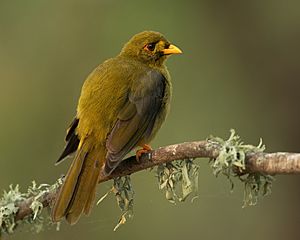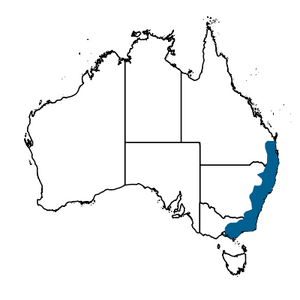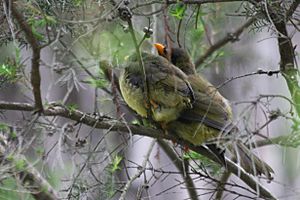Bell miner facts for kids
Quick facts for kids Bell miner |
|
|---|---|
 |
|
| Conservation status | |
| Scientific classification | |
| Genus: |
Manorina
|
| Species: |
melanophrys
|
 |
|
| Bell miner range | |
The bell miner (Manorina melanophrys) is a special bird from southeastern Australia. People often call it the bellbird because of its unique sound. It's a type of honeyeater. The word 'miner' in its name is an old way to spell 'myna'. Other birds in its family, called Manorina, also have 'miner' in their names.
Bell miners mostly eat tiny, dome-shaped coverings called 'bell lerps'. These lerps are made by small psyllid bugs. The bugs create them from their own sweet sap to protect themselves. These bugs live on eucalyptus leaves.
Bell miners live in big, organized groups. These groups have smaller families with breeding pairs. Other birds in the group, who are not breeding, help feed the young. They help all the baby birds in their family group. Bell miners work together to protect their home. They chase away most other birds. This helps them keep their food source, the bell lerps, safe. When forests get sick from too many psyllid bugs, bell miner numbers often grow quickly.
The village of Bellbrook NSW was named in 1882. It got its name from the clear, bell-like calls of these birds.
Contents
What is a Bell Miner?
The bell miner (Manorina melanophrys) is part of the honeyeater family. This family is called Meliphagidae. It also includes Australian chats. This bird family belongs to a larger group called Meliphagoidea. This group also has Australian warblers, fairy-wrens, and pardalotes.
Bell miners are in the Manorina group. Three other Australian miners are also in this group. They are the noisy miner, the yellow-throated miner, and the black-eared miner. The name Manorina comes from old Greek words. They mean 'thin' and 'nostrils'.
Early European explorers noticed the bell miner's bell-like call. The name 'bellbird' became common about 30 years later. This was after David Collins wrote about its "melancholy cry." In 1802, John Latham gave the bird its scientific name, Turdus melanophrys. This means 'black-browed thrush'.
Sometimes, people confuse the bell miner with the crested bellbird. However, these two birds have very different calls. They also behave differently. And they live in different parts of Australia.
How to Spot a Bell Miner
Bell miners are the smallest birds in their group. They are different from other miners. Other miners are mostly grey. Bell miners have olive-green feathers. Their wings are darker, and their bellies are yellower.
They are medium-sized honeyeaters. They weigh about 25 to 35 grams. They are about 17.5 to 20 cm long. Their wings can spread 22 to 30 cm wide.
They have a yellow beak that points slightly downwards. Their legs are bright orange. They also have a red-orange bare patch behind each eye. The top of their head and the area around their eyes are black. Yellow feathers are in front of their eyes. A dark line goes down from the corner of their beak. This makes them look a little like they are frowning. Their eyes are brown, and their mouths are yellow.
Male and female bell miners look similar. Males are usually a bit bigger. It's hard to tell them apart just by looking.
Young bell miners are browner than adults. Their colors are not as bright. Young birds do not have the bare skin patch behind their eyes. This patch slowly changes color as they grow. It starts pale grey, then becomes yellow, then light orange. Finally, it turns bright red-orange like the adults. Baby birds are born without feathers. They grow light brown fuzz after about two days.
You often hear bell miners more than you see them. They usually look for food high up in the tree tops. Their olive-green feathers help them blend in with the leaves. But they constantly make their "ping" calls. This helps them stay in touch with each other. In the Royal Botanic Gardens, Melbourne, bell miners sometimes come lower. This makes them easier to see and photograph.
Where Bell Miners Live
Bell miners live in eastern Australia. You can find them from Gympie in Queensland, south along the coast. They live down to Victoria, near Melbourne.
They like forests with lots of trees. These can be wet or dry forests. They often live near a stream or other water source. This means they prefer areas with more rainfall near the coast. They usually live next to rainforests, but not inside them.
Bell miners like dense habitats. They prefer areas with thick bushes and plants close to the ground. They don't like too many trees in the middle layer. They also like tall trees for the top layer. In natural areas, they choose places with shrubs, ferns, and vines. They have also been seen moving into disturbed areas. These areas often have a lot of the plant called lantana.
Bell miner groups can have 14 to 38 birds in one hectare. They are very picky about their homes. Even small changes, like a fire or removing lantana, can make a group move to a new place.
How Bell Miners Behave
Living in a Group
Bell miners live in big groups. These groups can have 8 to over 200 birds. Each big group has smaller family groups. These smaller groups are usually related male birds and their children. Each family group has several breeding pairs. These pairs stay together. They also have other birds who help them raise their young.
As a whole group, bell miners are very protective. They defend their home area together. They chase away other honeyeaters and any birds they see as a threat. They do this to protect their food source, the bell lerps.
Within the big group, each breeding pair has its own area to find food. The helper birds assist many breeding pairs. They move between different family areas. The family groups are connected. They interact every day because they are closely related.
Bell miners are known for being aggressive. They keep other birds out of their territory. Larger birds like kookaburras and crows are often attacked. Up to twelve miners from different families will mob them. They keep attacking predators if they stay in their territory. Small birds that stay low to the ground, like fairy-wrens, are often allowed to stay. But small birds that look for food higher up, or eat similar foods, are not allowed in.
One of the few birds that can sometimes push bell miners out is the noisy miner. But noisy miners usually like areas with fewer bushes. Bell miners can keep the numbers of other bird species low in their territory for many years. However, bell miner groups have clear boundaries. Outside these boundaries, the usual variety of birds returns.
What Bell Miners Eat
Bell miners mainly eat psyllid bugs. They also eat the young psyllid nymphs and their sweet lerps. Psyllid products can make up to 90% of a bell miner's diet. Bell miners look for food mostly on leaves, branches, and loose bark high in the trees. They usually stay at least 8 meters up. But sometimes they come down to the thick bushes below.
There's a theory that bell miners 'farm' psyllids. They might do this by keeping other psyllid-eating birds away from a large area. This way, the bell miners don't need to eat all the psyllids themselves. One idea is that bell miners might only eat older nymphs. Or they might eat the lerps but leave the nymph alive.
Studies have had mixed results on this theory. One early study didn't find proof in their stomachs. But a later study watched their behavior. It showed that bell miners carefully used their tongues to remove lerps. This left the nymph unharmed. In contrast, noisy miners pulled off both the lerp and the nymph with their beaks. When bell miners are removed from an area, other birds often move in. These birds quickly eat most of the psyllids.
Even though psyllids are their main food, bell miners also drink nectar. They get nectar from eucalyptus, banksia, and mistletoe flowers. They also eat other insects. These include spiders, beetles, moths, and wasps.
Bell Miner Associated Dieback
Bell miners are often linked to sick and dying eucalyptus trees. This problem is called Bell Miner Associated Dieback (BMAD). Many people are worried about BMAD. There are groups and plans to study it. Eucalyptus trees can get sick for many reasons. But there is a strong link between bell miners and sick trees. This was first noticed in 1982.
One idea is that bell miners 'farming' psyllids lets the bug numbers grow too high. This can make the trees sick and even die. In some places where bell miners were removed, other birds returned. The psyllid problem then got smaller. And the trees became healthy again. But in other studies, trees did not get better even after bell miners left. So, more research is needed to understand this link better.
Raising a Family
Bell miners usually stay in one place. They have a permanent home area where they also raise their young. The main breeding time is from April/May to August/September in the north. In the south, it's from June/July to November/December. But they can breed any time of year. Females often nest again if a nest fails. They also nest again after their young leave the nest. One female was seen nesting five times in one season. But this is not common.
Bell miner pairs stay together. But the male and female share the work differently. Female bell miners build the nest. This takes about 8 days. They sit on 1 to 3 eggs (usually 2) for about 14.5 days. They keep the young warm for up to 12 days. Nests are small and shaped like a cup. They are made of twigs, grasses, and bark. Spider webs hold them together. Nests are usually hidden in thick plants, 3 to 5 meters off the ground.
The eggs are about 24mm by 16mm. They are oval-shaped and pink. They have darker reddish-brown spots, mostly on the larger end. Sometimes, other birds like pallid cuckoos lay their eggs in bell miner nests.
Nests are all within the group's territory. But they are not packed close together. Nests are in the breeding pair's usual feeding area. They are usually close enough to hear other nests, but not too close. Female bell miners move their nests if a nest fails. They often move them lower into thick bushes. This likely helps protect them from birds that eat eggs. But they don't move nests far horizontally. This might be to stay in their usual feeding area. It also helps them keep their helpers. Females can also change the number of male and female chicks. If food is scarce, they might have more female chicks. These females will leave the group when they grow up. If food is plentiful, they might have more male chicks. These males will stay and become helpers.
Nest Helpers
Both parents and other helper birds feed and care for the baby birds. A nest can have up to 20 helpers. Nests are more successful when there are at least 6 helpers, besides the parents. Helpers feed the young. They defend the nest from predators. They also remove bird droppings and parasites. Helpers can be male or female. But most are young or breeding-age males. Young birds start helping when they are just over a month old. Older males who are not breeding help the most. They help with many nests.
The amount of help a bird gives depends on how related it is to the baby birds. Bell miners make a special call when they arrive at the nest with food. This call makes the young birds beg for food. These calls are similar among closely related miners. So, helpers prefer to help young birds whose fathers have similar calls to their own.
However, even helpers who are not related help a lot. There was no difference in how much help was given based on the sex of the chicks. Male chicks tend to stay with the group and become helpers. Female chicks usually leave.
Helpers will wait to bring food if the female parent is keeping the young warm. But they will eventually bring food, even if the female keeps brooding. The female is more likely to let the young be fed if the helper is her mate.
Growing Up
Young bell miners leave the nest after about 12 days. But their parents and helpers keep feeding them for another 10 weeks. Bell miners start helping at nests when they are less than 2 months old. This change happens slowly. Young birds will still beg for food from other helpers. Then they might eat the food or give it to younger birds.
Female bell miners usually leave the group when they are about 8 months old. They can start breeding at 8.3 months. It's possible that mothers become less tolerant of their daughters as they grow up. This might make the daughters leave. Many bell miners die before they can breed, about 93% of them. The biggest danger is right after they leave the nest. Many are eaten by predators. Known predators include the grey currawong, Australian raven, laughing kookaburra, and snakes. By the time they can breed, there are more males than females. This is probably because more females die when they leave the group.
Images for kids
See also
 In Spanish: Mielero cejinegro para niños
In Spanish: Mielero cejinegro para niños



